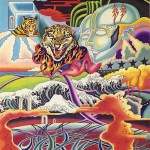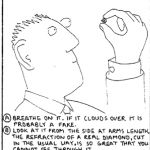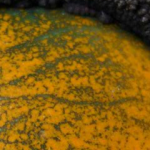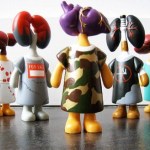Art
A slow June at the Fair (see here for an explanation), but I'm popping in to share what constitutes a different sort of landscape image(s) below. Here's the first:
The Citarum River in Indonesia.
Here we have landscapes of garbage, scenes of environments overwhelmed with waste, with excess, with disposed and disposable items. The images are jarring to me, especially when defined as landscapes -- that these are visions of the terrain in which we live. Nobody would confuse these for wilderness pictures. In this case, the human contrivance is too obvious to warrant comment, though In prior…
Kai and Anneli recently gave us a very welcome present: a cast of a lion mask from the Peerless Palace in Stockholm. North European Baroque is such a weird and lovely style. The wreck of the Vasa is a prime example, and there's a lot of it on the facades of houses in the Old Town too.
The Peerless Palace (Sw. Makalös) was on the spot currently occupied by the Carolus XII Plaza, within easy view of the Royal Castle across the water. It was built in the 1630s by Count Jacob De la Gardie who, among many other honours, was married to King Gustavus II Adolphus's old sweetheart Ebba Brahe. After…
Thanks to SEED's matching Bloggers Challenge funds and some generous donors who gave me DonorsChoose gift certificates for Christmas, I got to push several worthy projects to completion this winter (by "topping off" their funding). That meant that I got real, snail mail thank-you packages from those classrooms.
At first I was a little ambivalent because I didn't really want the kids to spend their valuable classroom time thanking me. But then I realized that while writing those thank-you notes, they spend at least a few minutes thinking about the fact that a complete stranger cares about…
Not so long ago it seemed that the "Lucy's Legacy" exhibit, which features the world's most famous fossil hominin, was coming to an end. The exhibition failed to bring in the crowds that were expected and there were doubts as to whether it would continue. According to a story about the exceptionally-talented paleo-artist Viktor Deak that appeared in this week's New York Times, however, it looks like Lucy is coming to Manhattan;
[Deak's] 78-foot-long mural showing six million years' worth of the proto-humans whose bony bits have been found in northeast Africa is coming to Manhattan in June as…
Evolve
Electroformed Copper, Vitreous Enamel, Sterling, Pearls, Lens, Feathers, Steel, Worm
Photo: Courtney Frisse
Last week I featured electroformed copper pendants by Kristina Glick Shank. I also found another outstanding electroformed copper artwork, this one by Kristin Mitsu Shiga. I think it's a wonderful idea to portray a chrysalid, the very symbol of transience, in metal - one of the most permanent materials possible. I am sorry it's titled Evolve - I don't love it when the concept of evolution is conflated with the concept of individual development. But this piece is so interesting…
A beautiful and macabre combination of anatomy and portraiture by Spanish artist Fernando Vicente.
I finally got around to reading my backed-up RSS feeds, and had the chance to peruse these, well, demented 1970s biology textbook illustrations uncovered by Crooked Timber. I mean, what? No - what??! Crooked Timber calls it a "Groovy Prog Rock Wannabe Biology Text." I don't know what to say, except that I went to Artomatic yesterday, which had something like a thousand artists, and this psychedelica is far trippier than anything I saw there. Whoa, man.
For the record, if I had, as a child, learned to associate biology with angry disembodied leopard heads flying towards me on Frisbees of fire…
I quite like this guide to fakery by kickass lo-fi science site Hunkins Experiments.
This is. . .
A. The surface of one of Jupiter's moons
B. Thermophilic archaebacteria in a hot spring
C. The pigmented iris of a Madagascar gecko
D. An electroformed enamel and copper pendant
E. Multicolored lichen at Enchanted Rock, Texas
Answer after the fold!
D* is correct: it is actually an enamel and copper electroformed pendant called "EyeSpy" by artist Kristina Glick Shank.
Shank's series of electroformed pendants impress me with their blend of controlled detail and organic (well, technically, mineral) textures. The electroforming gives an uncontrolled, natural feeling to the pieces…
DNA is most famous as a store of genetic information, but Shawn Douglas from the Dana-Farber Cancer has found a way to turn this all-important molecule into the equivalent of sculptor's clay. Using a set of specially constructed DNA strands, his team has fashioned a series of miniscule sculptures, each just 20-40 nanometres in size. He has even sculpted works that assemble from smaller pieces, including a stunning icosahedron - a 20-sided three-dimensional cage, built from three merged parts.
Douglas's method has more in common with block-sculpting that a mere metaphor. Sculptors will often…
As the last Zombie Identification Card was so popular, here's another. As you can see, my art is improving. All criticisms / suggestions welcome. The next will probably be Ampulex, simply because it's a strong visual, but I'd also like to makes some cards referencing other forms of zombification - i.e. Robert G. Heath's attempts to control psychiatric disorders using electrodes implanted into the brain.
Sacculina spp is a parasite of crabs.
She's beautiful and German. She's also naked, with very large breasts, and she isn't wearing any underwear — in fact, she's posing almost obscenely, and has rather prominent labia in view. She's also 35,000 years old and has no head.
A few other interesting details: she doesn't seem to be entirely naked— there are markings like bands and hatchmarks that are suggestive of some kind of clothing. More attention was paid to carving the hands, which have 5 and 4 fingers marked out, than to the head, which is nonexistent. In its place, there is a well-polished, carved loop, suggesting that she…
OMG! This Chris Beckett story is totally about me!
You can read the title story of The Turing Test online, and it's well worth checking out. In a dystopian future, Jessica runs a gallery where art increasingly involves human body parts and is designed to shock and appall bystanders.
Now I have to go read it. . .
via iO9
Image by Nicholas Conard
This sculpture may look a little bit like a roast chicken, but don't let that distract you - it's an incredibly important artistic find. This small figurine is arguably the oldest representation of the human body yet discovered.
The figure is clearly human, with short arms ending in five, carefully carved fingers, and a navel in the right position. But its most obvious features show that it depicts a woman, and very explicitly at that. She has large protruding breasts, wide hips and thighs, accentuated buttocks and pronounced vulva between her open legs. In contrast…
Well, not really. Artist Carel Brest van Kempen timelapsed stills of an acrylic painting to show his work process. It's remarkable how quickly the anole comes to life!
I especially enjoy watching the glazes go on and come off - each time he blots out part of the painting, I think, "oh NO!" But that's because I work in watercolor, which is pretty near irreversible. Acrylic is much more forgiving.
Here's a little something I made for a project I'm working on. A blend of science and surreal humour. Tell me what you think. Yay or nay?
Cordyceps unilateralis is a parasitic fungus of ants. It really does exhibit mind-control capabilities.
This week, Nieman Journalism Lab is running a fascinating series of video interviews with the New York Times' R&D group on the possible future face of news media. I know - you're wondering why the supposedly financially moribund NYT is wasting money on nerds who play with Kindles. Who do they think they are, Google? But it might be a good strategy after all.
As Fortune and the Columbia Journalism Review recently pointed out, with outlets all around them slashing premium content (like science), the NYT's best strategy may be to instead become increasingly "elite:"
Meanwhile, the company is…
Okay, these dolls by David Foox are just plain disturbing. And they're not just a concept - you can actually BUY ONE.
Via Street Anatomy.
Do you like Permian synapsids? If you do then you definitely should check out this month's edition of the ART Evolved carnival. I particularly like Nima Sassani's Greg-Paul-like illustration of a pack of Inostrancevia.
And it's gorgeous. Holbo has found a set of scans from a 1972 biology textbook (and an associated blog) that will blow your mind, baby. Here are some eukaryotic cells.
I think this is a very trippy metaphor for the synapse.
I like it. It's got style. I'm going to have to cruise some used bookstores to see if I can find a copy of Biology Today. If nothing else, I can imagine using some of those illustrations for talks…I'm also going to have to get a polyester suit with very wide lapels and a paisley print shirt, let my hair grow out, and shave the beard, but keep the mustache. Oh, I remember…







